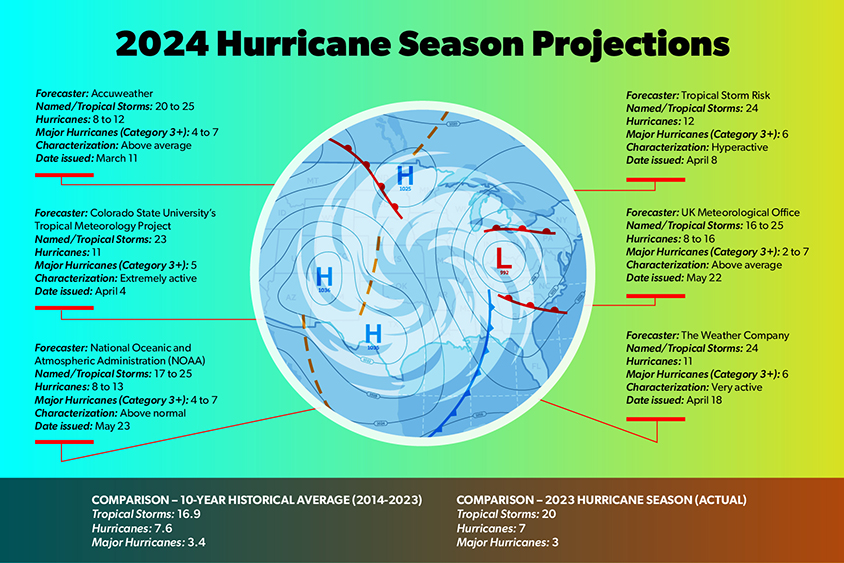Hurricane season officially began on June 1 and a slew of expert predictions indicate it may be another storm season for the record books. Indeed, major forecasters have predicted nothing less than an “active” season, with some going so far as to characterize it as “hyperactive” or “super-charged” (see infographic below). Record-high ocean surface temperatures and an imminent shift from El Niño to La Niña conditions point toward prime conditions for the formation of more tropical storms this season, and greater severity in the storms that form.
Meteorologists Agree on Above-Average Forecasts
In a June 11 update, Colorado State University’s Tropical Weather and Climate Research team reiterated its pre-season forecast, predicting 23 named storms, 11 hurricanes and five major hurricanes (Category 3 and up) and stated its research scientists have “above-normal confidence” in their predictions this season “based on the strength and persistence of the current hurricane-favorable large-scale environmental conditions.”
Similarly, on May 23, the National Oceanic and Atmospheric Administration (NOAA) reported an 85% chance of an above-average season, predicting 17 to 25 named storms, of which eight to 13 could be hurricanes with winds of 74 mph or more (Category 1 and up), and four to seven major hurricanes with winds of 111 mph or more (Category 3 and up). NOAA noted its forecasters have 70% confidence in these ranges.
Forecasting company Atmospheric G2 and the Weather Company, the firm behind the Weather Channel, released their “most aggressive hurricane prediction” since they began issuing outlooks in 2006, saying it could be one of the most active Atlantic hurricane seasons on record.

Key Factors in an Active Hurricane Season
Two key factors point toward an extreme season. First, according to Dr. Sam Burgess, deputy director of the Copernicus Climate Change Service at the European Centre for Medium-Range Weather Forecasts, the North Atlantic Ocean has experienced over 14 straight months of record-high ocean surface temperatures. Other factors being equal, the deeper and warmer ocean water is, the stronger the hurricanes that form over them can become. When the Weather Company’s prediction was published in April, ocean temperatures were already as high as one would expect during peak disaster season. “Hurricane season generally begins when water temperatures warm to around 80 degrees, which usually occurs between June 1 and Nov. 30,” the Weather Channel explained. “Water temperatures in the Atlantic’s Main Development Region (MDR), which stretches from the Lesser Antilles to West Africa, [are] as warm as it should be in late June or early July.” Further, on June 8, CSU chief research scientist Philip Klotzback noted current water temperatures in the Caribbean were, on average, not usually reached until September 2 and were never reached at all in 2018.
Second, El Niño weather conditions are imminently expected to shift into La Niña, which can be one of the strongest influences on hurricane season. “In general, La Niña Atlantic hurricane seasons have less wind shear that can otherwise rip storms apart, and rising, unstable air that is more conducive for thunderstorms, the building blocks of tropical storms and hurricanes,” according to the Weather Channel. “This means instead of El Niño acting as a gentle brake on hurricane season, La Niña could instead step on the gas pedal.”
In addition to a larger number of storms, meteorologists believe this year’s tropical storms may have greater impact in terms of landfall. CSU’s updated predictions noted “well above-average probability for major hurricanes making landfall along the continental United States coastline and in the Caribbean.” Atmospheric G2’s forecasters also expected the season to be more impactful, with storms making a higher number of landfalls, predicting a higher-pressure system over Bermuda and the Azores would push more storms west, toward the Caribbean and the United States.
With the exception of a small number of severe storms, last hurricane season may have seemed relatively tame for many observers—until you look at some of the data. As Allianz noted in its 2024 hurricane season outlook, while the 2023 season saw few storms actually make landfall, 20 named storms formed, exceeding predictions by six and ultimately making it the fourth-most active year on record. What’s more, 13 named storms formed between August 20 and September 28, the most ever recorded in this period. For the first time since record-keeping began, two named storms also formed at the beginning of the season in June 2023, furthering some discussion of hurricane season expanding with climate change.
Planning Ahead for Tropical Storms
While hurricane season officially runs from June 1 to November 30, according to Philip Klotzbach, nearly 95% of all major hurricanes (Category 3-5) have historically occurred from August through October. In other words, 95% of hurricanes have struck during 50% of the season. This season-within-a-season should offer a secondary target date for organizations to ensure they have strong disaster preparation and response plans. Hopefully, risk managers already have robust plans and insurance coverage in place, but there is still time to either create or strengthen risk management measures before the threat increases.
To help “give your business the best chance of withstanding and recovering from an extreme weather event,” Allianz recommended the following five steps to boost storm resilience:
- Update and test your emergency preparedness plans: Preparation before the storm minimizes property damage and reduces business interruption. Ensure your business has a comprehensive written emergency response plan for extreme weather events, including high winds and flood. A good plan has the support of senior management, site-specific recommendations, and clear delineation of responsibilities.
- Test and update business continuity plans annually: The crucial role of business contingency plans has become more apparent as a result of recent natural catastrophes. If a storm is expected to hit on a weekend or a Monday, it can make it difficult for employees to develop and implement business contingency plans while preparing their homes and families for the storm. A well-developed contingency plan provides businesses with the tools to get back up and running as quickly as possible.
- Understand your insurance policy: Business owners should take the time to read their current policy and discuss with their brokers what is covered and where there may be gaps. Determine if the limits of liability are in line with the current dollar value of the cost to repair or replace the damage. Consider adding an extended period of indemnity clause to the business interruption coverage to support the business until it returns to its pre-loss financial condition.
- Know what to prepare for: Planning for a wind event involves different preparation than planning for flooding. In the case of an event such as Superstorm Sandy, which occurred in 2012, most preparation was based on a high-wind event, leaving many businesses unprepared for the flooding caused by the storm surge. As more sophisticated tracking models are introduced, more accurate information will become available.
- Consider making improvements to the building and site: The following enhancements could help your business withstand the high winds and flooding that can accompany a windstorm:
- Emergency generators for loss of power
- Floodgates and flood doors
- Raising critical equipment above highest anticipated flood levels
- Protecting the building envelope from high winds (this refers to the physical boundaries between the interior and exterior of a building, such as the roof, windows and doors). This could include measures such as using impact-resistant doors and glass, or providing additional securement of the roof covering system to the roof deck.
Additionally, the Insurance Institute for Business and Home Safety offers a range of tools for organizations to develop detailed business continuity and disaster recovery plans, which can be found here.
To help fortify against hurricanes or navigate disaster response and insurance claims, the following articles from Risk Management can also help risk professionals and their organizations weather the storms to come:
- Pre- and Post-Storm Checklists
- Key Considerations for Disaster Planning
- Remote Workforce Considerations for Natural Disaster Preparation
- Reviewing Your Insurance Coverage in Advance of Hurricane Season
- Hurricane Claims: Key Tips to Minimize Losses and Maximize Recovery
- Employer Obligations in Disaster Response
- Maximizing Insurance Recovery When Disaster Strikes
- Best Practices for Preparing a Business Interruption Claim














